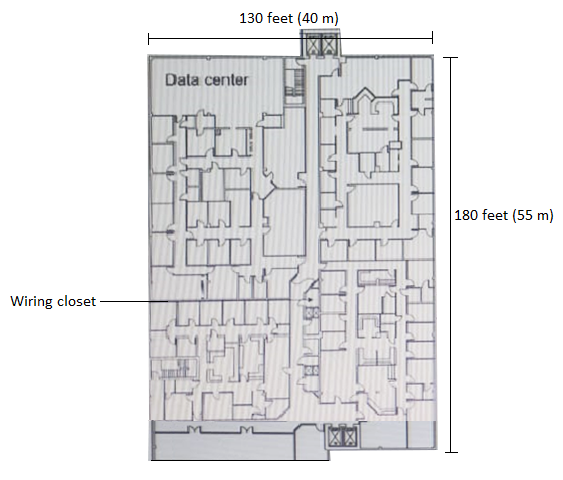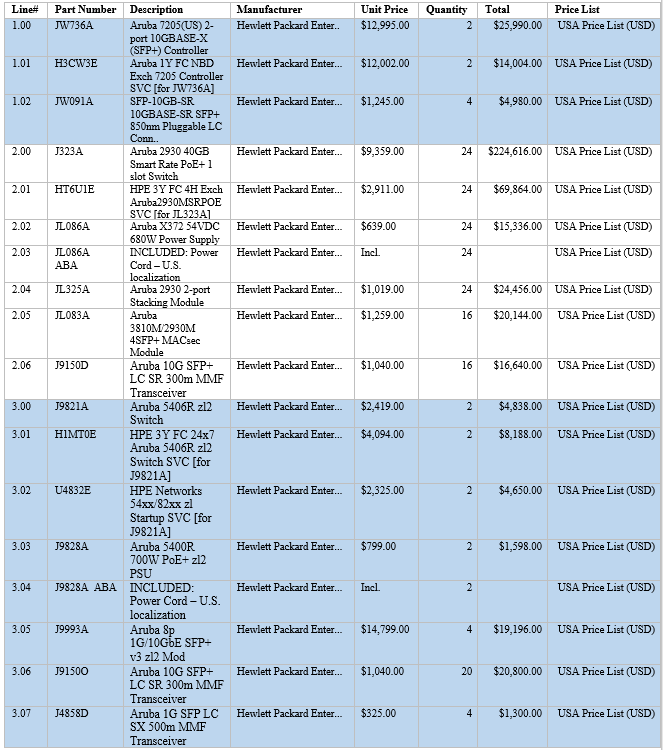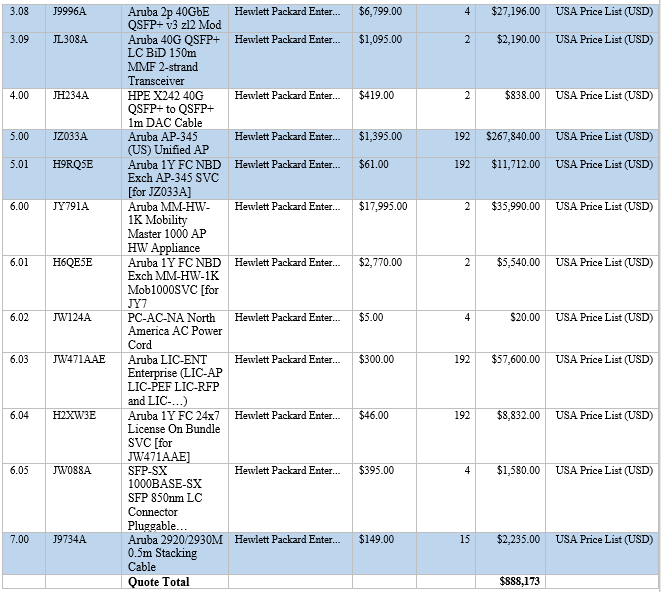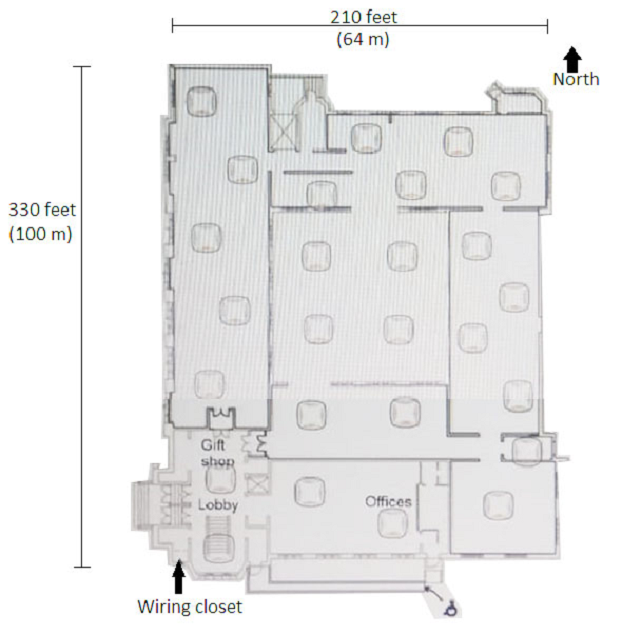Aruba Certified Design Expert 8 Written Exam v1.0
Question 1
Refer to the exhibit.

The customer requires a solution for the writing closet shown in the exhibit. The closet serves the entire floor, which is wired for CAT5e cable. The closet has four
CAT5e cables to the data center 110 feet (34 m) away.
The switch or switches in this closet will need to support 100 wired endpoints and 16 AP-345s. The switch or switches must connect to the network core, Aruba
5406R switches, in the data center on uplinks that provide at least 20 Gbps bandwidth total.
What is one benefit of an Aruba solution for meeting these requirements?
- A. AOS-Switches can meet the uplink bandwidth needs with an extensive array of choices for transceivers.
- B. Aruba PoE+ ports can provide more than 30W of power even to APs at the fat end of the floor.
- C. Aruba Smart Rate ports enable switches to achieve the required uplink speeds without expensive re-cabling.
- D. Aruba conditioning mode cables enable 10GbE SFP+ of 40GbE QSFP+ connections on copper cabling.
Answer : B
Question 2
Refer to the exhibit.


The network architect has created the BOM shown in the exhibit for a complete new wired and wireless solution for a customer. This solution will support 6000 wireless clients and 900 wired clients.
The customer wants to discover and manage every component of the network in AirWave, including MMs, MCs, APs, and switches.
How many AirWave licenses does the architect need to add?
- A. 30
- B. 222
- C. 6930
- D. 7122
Answer : A
Question 3
Refer to the exhibit.

A museum wants to add full 802.11ac wireless coverage across the building, which is about 210 feet (64 m) by 330 feet (100m). The museum has 15-foot (4,6 m) ceilings and stone interior walls. The network needs to support up to 600 wireless guest devices.
The exhibit also shows a preliminary plan for AP locations. The museum has eight Ethernet drops in the lobby and gift shop, but has otherwise not been wired.
What is one recommendation that the architect should make to ensure a successful deployment?
- A. use of directional antennas to avoid lost signal
- B. addition of a writing closet closer to the north side
- C. use of at least CAT5 cable to connect to the APs
- D. addition of about 10 APs to achieve adequate density
Answer : C
Question 4
Compare the scenarios below. For which scenario do AP-365s meet the needs?
- A. The customer needs APs mounted to a concrete building exterior to provide coverage in a 90 foot (27m) radius from the building.
- B. The customer needs APs for an indoor high density environment in which the customer prefers dual 5GHz operation.
- C. The customer needs to mount APs in an outdoor area, but that area only has fiber cable available.
- D. The customer needs APs for an indoor stadium that requires overhead coverage and directional antennas.
Answer : A
Question 5
A customer has multiple, very small branch sites that require just one or two APs each. The office has a local Internet connection, but the traffic is destined to the corporate data center, which has an Aruba wireless solution.
Which branch office solution best meets the customer needs?
- A. RAPs and 7005 branch office controllers with an SD-WAN license
- B. RAPs and no branch office controllers
- C. CAPs and 7005 branch office controllers
- D. IAPs and 7005 branch office controllers with an SD-WAN license
Answer : D
Question 6
A university has a dormitory with several floors. Currently APs are deployed in the hallways about every 50 feet (15m). The university has several issues with the existing network:
-> Students complain that the network is very slow, and the wireless signal is poor.
-> Students want to connect some equipment such as gaming consoles and IP TVs on Ethernet, but the dorm rooms just have one Ethernet port.
How does the deployment of AP303Hs resolve the customer issues?
- A. They are specialized to provide wireless coverage for single-room deployment and also provide wired ports for clients.
- B. They are specialized for wireless meshing, which conserves Ethernet ports, and for high-speed wireless services.
- C. They have high-gain antennas designed for older buildings and support Smart Rate for high bandwidth on one port.
- D. They have directional antennas that will improve the wireless signal and require just one Ethernet port.
Answer : C
Question 7
A network architect plans to propose a virtual Mobility Master (VMM) for a new solution. The solution will support up to 4,800 wireless client devices and include:
-> two Virtual Mobility Controllers (VMCs) in a cluster
-> 180 APs
Which licenses should the architect propose?
- A. 1 MM-VA-500; 2 MC-VA-250; 540 Enterprise licenses
- B. 1 MM-VA-500; 1 MC-VA-250; 180 Enterprise licenses
- C. 1 MM-VA-1K; 2 MC-VA-250; one Enterprise license
- D. 1 MM-VA-1K; 1 MC-VA-250; 180 Enterprise licenses
Answer : C
Question 8
A school district has instant APs (IAPs) at multiple locations. The school district wants a simpler way to manage the IAPs from a single location. However, it does not have the IT staff to handle the installation and management of a management solution on site.
What should the architect recommend?
- A. Purchase a subscription for Aruba Central device management.
- B. Deploy Aruba AirWave in central location.
- C. Purchase licenses for a Virtual Mobility Controller (VMC).
- D. Deploy an Aruba MC in a central location, and convert IAPs to CAPs.
Answer : A
Question 9
A customer has an existing Aruba wireless solution to provide wireless access for employees. The solution includes APs, mobility controllers (MCs) at the network core, and a Mobility Master (MM). A customer would like to set up a separately managed guest network and have the traffic go directly to the DMZ.
What should the architect suggest as the simplest solution that meets the requirements?
- A. Add APs in a dedicated AP group to support only the guest network SSID.
- B. Have a dedicated mobility controller in the DMZ managed by the same MM.
- C. Double the number of APs and controllers
- D. Use MultiZone, and put a mobility controller in the DMZ.
Answer : D
Question 10
In which scenario do Aruba 2930M Series switches, but not Aruba 2930F Series switches, meet the needs for an upgrade of the wired access layer?
- A. Each switch must support 48 1Gbps edge ports, and the uplinks must be redundant as well as provide no worse than 10:1 oversubscription.
- B. The customer requires enhanced redundancy at the access layer and wants to ensure that each switch can continue to operate even if a power supply fails.
- C. The customer requires switches in the same closet to connect together into a single virtual switch that is managed and operates as a single device.
- D. Each switch must support mostly non-PoE devices, but also at most four Aruba AP-345s which require PoE+ to support the full requirements for the customer scenario.
Answer : A
Question 11
What is one reason that an architect might choose to use pico-cell coverage rather than overhead in a stadium?
- A. to avoid major rewiring and construction concerns
- B. to save money by using less powerful and less expensive APs in the deployment
- C. to support a higher device density with a higher level of channel reuse
- D. to maximize coverage per-AP through the use of calculated directional antennas
Answer : C
Question 12

A stadium wants to deploy location-based services, including blue-dot wayfinding over a 200,000 square foot (18,580 sq. m) area. The customer also wants to enable targeted notifications when guests walk past particular areas. The customer has selected a 1 year subscription.
The exhibit shows the BOM that the architect created in Iris.
Which correction should the architect make?
- A. Add another campaign subscription
- B. Add two Maps subscriptions
- C. Remove one Blue Dot Nav subscription
- D. Change the campaign subscription to a Maps subscription
Answer : B
Question 13
A customer has a campus that has expanded to several buildings. The buildings are between 100 and 200 feet (30 m and 61 m) apart and connected with SM fiber. The customer currently has instant APs (IAPs) clusters on several floors of several buildings. The customer has consolidated central resources in a small data center in one of the buildings.
The customer would like a more centralized architecture in which all wireless traffic is tunneled to the data center and IAPs are managed centrally.
What should the architect recommend?
- A. Deploy Aruba MCs in a central location, and convert IAPs to CAPs.
- B. Purchase a license for a Virtual Mobility Master (VMM).
- C. Deploy Aruba AirWave in a central location.
- D. Purchase a subscription for Aruba Central device management.
Answer : D
Question 14
In which of these scenarios do the customer requirements point towards tunneled node, or dynamic segmentation, on AOS-Switches?
- A. A customer has wired IoT devices and wants to be able to control their access. The architect recommends sending all of their traffic through the MC role-based firewall.
- B. A customer wants to manage their AOS-Switches in a more centralized manner. They would like to connect AOS-Switches to AirWave over secure IPsec tunnels and control all configuration from there.
- C. A customer has a branch office with an AOS-Switch and an Internet connection. The customer would like to give branch office users secure access to the corporate LAN over an IPsec tunnel.
- D. A customer lacks physical security and wants to impose 802.1X authentication on wired ports. After employees complete 802.1X authentication, they should receive full access to the network.
Answer : B
Question 15
A retailer wants to provide wireless services for guests across a section of store floor, which consists of 82 foot (25m) long aisles of cans and dry food goods. The shelves are six feet (1.8 m) high, and the ceiling height is 13 feet (4 m) high.
The architect recommends overhead APs deployed at 40-50 foot (12 to 15 m) intervals every few aisles rather than in every aisle.
What is one factor that justifies this recommendation?
- A. the low transmit power of most guest devices
- B. the low shelf height relative to ceiling height
- C. the aisle length
- D. the low ceiling height
Answer : B